A lot has been said, penned, and documented about the famous experiment known as “Biosphere 2” (B2). For anyone whose formative years coincided with the early 90s, this name probably sounds familiar. Since the project launched in 1991, it has been heavily publicized, criticized, and was even the subject of a documentary – titled “Spaceship Earth” – that premiered in May of 2020.
To listen to some of what’s been said about B2 (even after 30 years), one might get the impression that it was a failure that proved human beings cannot live together in a sealed environment for extended periods of time. But in truth, it was a tremendous learning experience, the results of which continue to inform human spaceflight and ecosystem research today. In an era of renewed interplanetary exploration, those lessons are more vital than ever.
This is the purpose behind the Space Analog for the Moon and Mars (SAM²), a new analog experiment led by Kai Staats and John Adams. Along with an international team of specialists, experts from the University of Arizona, and support provided by NASA, the National Geographic Society, and commercial partners, SAM² will validate the systems and technology that will one-day allow for colonies on the Moon, Mars, and beyond.
As noted, the B2 experiment conducted vital scientific research and achieved some impressive feats in the process. For starters, it set world records for closed ecological and biological systems, agricultural production, nutrition, and atmospheric dynamics. During its second run (Mar. to Sept. of 1994), the experiment achieved total self-sufficiency in terms of food production and oxygen.
As Matt Wolf, director of the B2 documentary, “Spaceship Earth,” summarized:
“I look at it as a story about human ambition, its possibilities, and limitations. I think the experiment revealed that humans are the most unstable element of a closed system… The media can be very dismissive of people trying new things. So much so that people hesitate to try for fear of criticism or failure. If everybody feared failure, they would never try new and ambitious things.”
Today, with crewed missions to the Moon and Mars on the horizon, the need for closed ecosystem experiments is absolutely necessary. This is especially the case seeing as how no experiments of this kind have been conducted since the mid-90s.
Luckily, Kai Staats – an independent scientist with projects and positions at Northwestern/LIGO, Arizona State, and the University of Arizona – and John Adams (the Deputy Director of the B2 experiment), have come together with an international team to launch such an endeavor. Using the same grounds as B2, SAM2 will be an extension of B2’s original research.
As humanity embarks on a new era of space exploration that includes plans to create habitats on the Moon and Mars, the lessons provided by B2 and SAM² will provide vital data that could very well be the difference between success and failure – or in the context of deep-space exploration, between life and death.

According to John Adams, the lessons of B2 are indispensable to making humanity an “interplanetary species,” as well as tackling climate change. As he told Universe Today via email:
“The single biggest takeaway is how little we understand Earth systems and their complexities. The research at B2 has developed a mechanistic understanding of how the atmosphere is influenced by landscapes and what that means for future climate, the dynamics of weather, and the fate of our water resources, and complex (non-linear) influences of all these changes on biological systems.
“No facility currently exists that provides this level of experimental control and integration across a range of spatial scales, combined with proximity to a funded natural laboratory and an organized interdisciplinary team to address the geologic, chemical, biological, and atmospheric aspects of the earth system.”
An Ambitious Project
The B2 experiment was originally conceived by Texas billionaire and philanthropist Ed Bass and ecologist and inventor John P. Allen. In the 1970s, the two met up at Synergia Ranch, an innovation community retreat founded by Allen in 1969 near Santa Fe, New Mexico. While there, the two discussed the idea of biospheres, closed ecological systems, and the concept of “Spaceship Earth.”

This concept was originally proposed by famed architect, designer, and systems theorist Buckminster Fuller. In his seminal book, Operating Manual for Spaceship Earth (1969), he stated that:
“[W]e can make all of humanity successful through science’s world-engulfing industrial evolution provided that we are not so foolish as to continue to exhaust in a split second of astronomical history the orderly energy savings of billions of years’ energy conservation aboard our Spaceship Earth. These energy savings have been put into our Spaceship’s life-regeneration-guaranteeing bank account for use only in self-starter functions.”
The facility also incorporated Buckminster Fuller’s patented design for geodesic polyhedron domes to create B2’s “Lungs” – the artificial structures that expanded and contracted to neutralize the pressure differences and keep the facility airtight. In 1984, Bass and Allen purchased the property in the Arizona Desert, where B2 would be built.
Construction was carried out between 1987 and 1991 and was overseen by Space Biosphere Ventures, a joint endeavor founded by Bass and Allen, along with several of their colleagues from the Synergia Ranch.
They included artist and entrepreneur Marie Harding, co-founder of Institute of Ecotechnics and; Margaret Augustine, CEO of B2 and chief architect of many related projects; Dr. Mark Nelson, an ecological engineer and co-founder of the Institute of Ecotechnics (IoE); Abigail Kingsley Alling, founder and president of the Biosphere Foundation; and William F. Dempster, president of IoE (1983-86) and the director of Ocean Expeditions (1987-1993).
The first experiment began in the Fall of 1991, when eight explorers were placed into a $150-million facility outside of Oracle, Arizona. The facility consisted of roughly 670,000 m² (7,200,000 ft²) of interior space beneath sealed glass, which was divided into seven biomes distributed over 3.14 acres of land. Each of these biomes was designed to mimic a different environment here on Earth, which consisted of a:
- 1,900 m² (20,000 ft²) rainforest
- 850 m² (9,100 ft²) ocean with a coral reef
- 450 m² (4,800 ft²) mangrove wetlands
- 1,300 m² (14,000 ft²) savannah grassland
- 1,400 m² (15,000 ft²) fog desert, and two anthropogenic biomes
- 2,500 m² (27,000 ft²) agricultural system
- human habitat with housing, labs, offices, classrooms, and workshops
These analog environments were near-perfect representations of their real-life counterparts, with indigenous flora and fauna and ambient temperature and humidity conditions set just right. The basement area, known as the “Technosphere,” housed all the electrical, plumbing, and mechanical systems for the experiment.
This included the 26 air handlers (AH) that would heat and cool the air, remove particulate matter, control humidity, condense water for rain, fog, and replenishing the ocean. Further heating and cooling were provided by passive solar input through the glass panels that covered most of the facility, plus an independent piping system that circulated water throughout. Electrical power was supplied from an on-site natural gas energy center.
The Biosphere 2 experiment was used as a sealed biome only twice, once from 1991 to 1993, and the second time from March to September 1994. The first experiment ran into serious problems that were heavily-publicized, which included a breakdown in the group dynamic, an internal power struggle, management issues, and a spike in CO² levels. Several improvements were adopted to prevent this issue from happening again.
Unfortunately, the second experiment ran into problems that culminated with the dissolution of Space Biosphere Ventures (the managing company) in 1994. A year later, Columbia University stepped in and took over the management of the facility. It continued to run experiments there until 2003. By 2007, the University of Arizona took over the experiments and assumed full ownership of the facility by 2011.
Today, B2 is currently the world’s largest indoor ecology research center with an extensive array of experiments. Since 1991, it has been visited by no less than 3 million patrons, half a million of which were K-12 students. The facility has since become a source of renewed interest thanks in part to a renewed interest in human space exploration.
The lessons it offered have also informed experiments like NASA’s Hawaii Space Exploration Analogue & Simulation mission to Mars (Hi-SEAS), the open-air Mars analog experiment located at the summit of Mauna Loa in Hawaii. A total of six NASA-funded studies have taken place in this facility since 2013, which involve crews living in a sealed Martian habitat and conducting outdoor research in mock spacesuits for up to a year.
The Mars Society also operates two open-air analog environments, which include the Flashline Mars Arctic Research Station (on Devon Island in the Nunavut Territory, Canada) and the Mars Desert Research Station in Utah. Both locations have been in operation since the early 2000s and simulate conditions on Mars – one being very cold, the other very dry.
Then there’s China’s Yuegong-1 (“Lunar Palace 1”), a 160 m2 (1700 ft²) self-contained laboratory in Beijing designed by the Beijing University of Aeronautics and Astronautics (BUAA) to simulate a lunar habitat.
Between February and May 2014, a team of three researchers was sealed inside this “bioregenerative life support system” (BLSS), where they subsisted on a diet of select crops and mealworms. This was followed by a record-setting year-long experiment where eight volunteers remained inside from May 10th, 2017, to May 15th, 2018.
In 2018, China began developing the C-Space Project Mars in the hills of Gansu province. Currently, the facility is intended for tourists to train them living on Mars would be like. However, the long-term aim is to convert the facility into an astronaut training center for future missions to Mars.
The European Space Agency (ESA) maintains a research station in Antarctica known as Concordia. The facility, which is operated by the French Polar Institute (IPEV) and the Italian Antarctic Program (PNRA), is located more than 1000 km (620 mi) from stations on the coast and has been used to conduct studies into psychology, physiology, and medicine, sometimes lasting for a full winter.
NASA also maintains an open-air, three-story artificial habitat called the Human Exploration Research Analog (HERA) at the Johnson Space Center. Since 2014, HERA has served as an analog environment to train astronauts how to deal with isolation, confinement, and remoteness scenarios during exploration missions.
There’s also the NASA Extreme Environment Mission Operations (NEEMO), which involves astronauts, engineers, and scientists spending up to three weeks at a time in Aquarius. Located in the Florida Keys National Marine Sanctuary, Aquarius is one of only three active undersea research stations in the world. The Aquarius habitat and its surroundings provide a high-fidelity analog environment that allows NASA to test tools and techniques.
Between 1965 and 1972, the Russian Academy of Sciences (RAS) built the BIOlogical closed life support System (BIOS-3) research facility in Krasnoyarsk, Siberia. The facility consisted of a 315 m³ (3390 ft³) habitat that could support a crew of three. It was divided into four compartments, consisting of a crew area and three “phytotrons” for growing wheat and vegetables.
Air quality was maintained in part by photosynthesis, where chlorella algae grown and stacked under artificial light would remove CO² and add oxygen gas to the recycled air system. Another process involved heating organic compounds to 600 °C (~1100 °F) in the presence of a catalyst was used to purify water, and air and nutrients were also recycled. By 1968, BIOS-3 reached a system efficiency of 99% in terms of recycling its air, 85% in terms of recycling water, and about 50% for recycling food and nutrients.
The RAS also conducted experiments between 2007 and 2011 using their Mars-500 analog environment. In cooperation with the ESA, the RAS Institute of Biomedical Problems (IBMP) placed a multinational crew of six into this habitat for a 520-day simulated mission to Mars to learn more about the psychological implications of long-duration spaceflight.
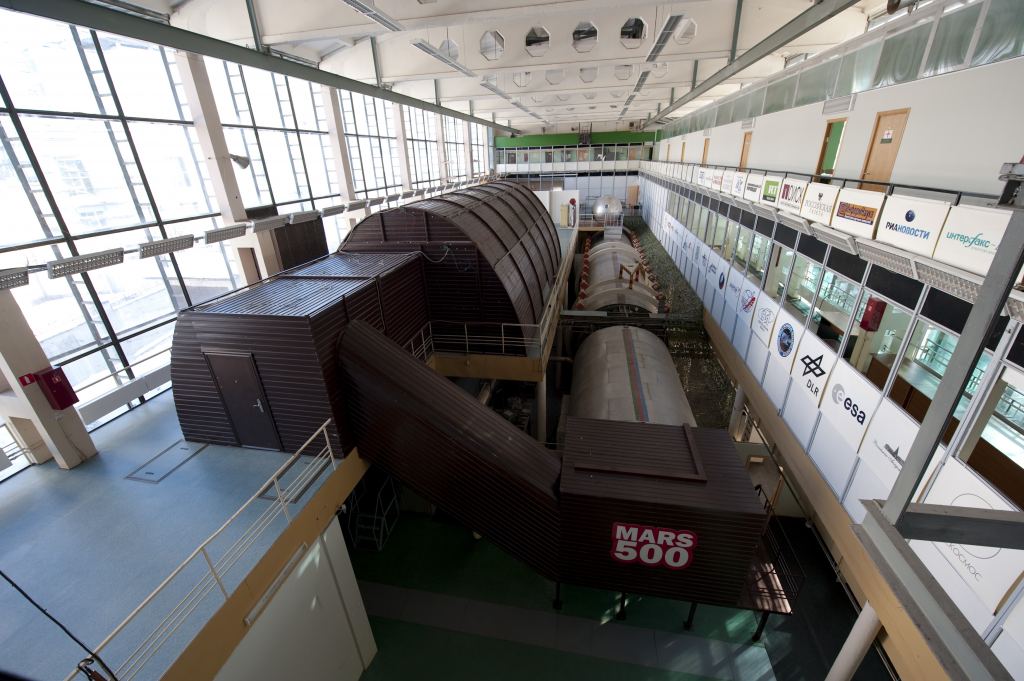
There’s also the Scientific International Research in Unique terrestrial Station (SIRIUS) experiments being conducted by the Institute of Biomedical Problems (IBMP) in Moscow, Russia. With support provided by the NASA Human Research Program (HRP), these investigate the effects of isolation and simulated flights to the Moon.
In 2017 and again in 2019, experiments were conducted where six volunteers lived and worked in a simulated spacecraft and lunar space station (the Lunar Gateway) – which lasted 17 and 122 days, respectively. In 2021, SIRIUS will conduct an eight-month experiment with the participation of the European Space Agency (ESA).
In all cases, the purpose of analog studies has been to learn all we can about humans living together in closed environments, where they will be dependent on a fixed amount of resources and what they can produce for themselves. In addition, all of these experiments have leveraged what we know about the complex, interdependent systems we depend upon here on Earth for our survival.
Applications for Space and Earth
From its inception, the B2 experiment has recognized the connection between living in space and life here on Earth. By understanding the intricacies and complexities of ecological systems, the B2 team hoped that humans could learn what they needed to live on other planets while also living sustainability here at home. This is not unlike James Lovelock’s Gaia Hypothesis, which views Earth as a single self-sustaining organism.
Lovelock formulated this hypothesis while working at NASA’s Jet Propulsion Laboratory, where he was developing climate models that would assist in the search for life on Mars. The name was inspired by the fact that its creators were attempting to simulate Earth’s own biosphere. In other words, the experiment was Biosphere 2 because Earth is Biosphere 1.

As Robert “Rio” Hahn, a Royal Geographical Society Fellow and the director of marketing and communications for B2, explained:
“There were three main goals for Biosphere 2. The first was to deepen our understanding of how Biosphere 1 operated. That’s the biosphere we all live in. The second goal is to develop the technologies that would enable us to do long-term space travel and establish habitation on other planets. The third goal of Biosphere 2 was public education of what a biosphere is, that we as humans live inside of a biosphere.“
Dr. Nelson, who served as B2’s Director of Earth and Space Applications from 1991 to 1994, has since written and co-authored several books that describe the experience and the valuable lessons it provided. These include The Wastewater Gardener: Preserving the Planet One Flush at a Time (2014) and Pushing Our Limits: Insights from Biosphere 2 (2018), and Life Under Glass: The Inside Story of Biosphere – which he co-wrote with his wife and fellow “Biospherian” Abigail Alling.
As Dr. Nelson described it, the B2 experiment was a “life support system that is materially closed, energetically open (with sunlight and power sources), and informationally open”:
“Inside Biosphere 2, everything made sense. Everything you did, you could see the impact of it. No anonymous actions. It was like my body suddenly got the message: every time you breathe, these plants are waiting for your CO2. They are your third lung. I thought, ‘My God, this is keeping me alive! I am absolutely metabolically connected to the life here.’”
Today, researchers and engineers are engaged in lucrative research, developing the technologies that will allow for long-duration missions on the Moon, Mars, and beyond. Much of their work has been informed to a large extent by B2 and similar research in closed ecological systems.
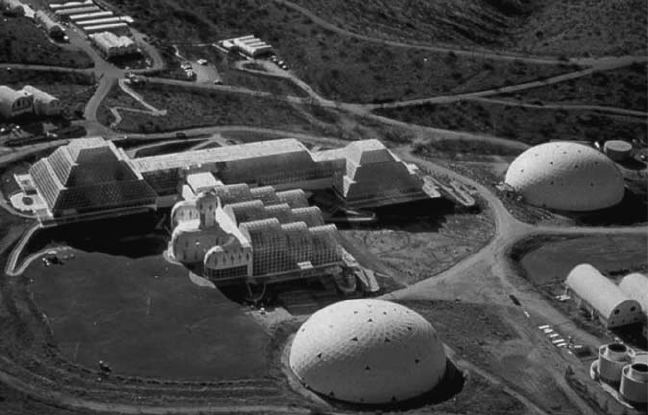
The Next Step
Leveraging the lessons and techniques that B2 demonstrated, Staats and a crack team of colleagues from the United States, Canada, Russia, and Italy came together to create SAM². With the help of plant experts from the UofA and additional support from NASA, Nat Geo, and others, SAM² will be an analog research station that is as close to the real thing as possible.
The SAM² experiment is located on the same campus as Biosphere 2 (near Oracle, Arizona) and will utilize the B2 Test Module. During the construction of B2 in the late 1980s, the Test Module (TM) was where small-scale enclosure tests were carried out, as a sort of dress rehearsal for the main experiment. In total, three closure tests were conducted with the TM, where a single inhabitant was sealed inside for a month.
For each test, a healthy internal atmosphere and agricultural area were maintained, and all water and human waste was recycled. These tests validated a number of systems and processes that were vital to the B2 experiment. These included potable water generation, atmospheric sealing, mitigation of thermal expansion and contraction, and the behavior of agents in a closed ecological system.
“One of the biggest unknowns is the influence and development of the microbiome,” said John Adams. “We know it is a key factor but do not understand how its development/evolution is driven. We hope to use SAM² in part to understand the microbiome development from a sterile environment to an environment where teams are coming and going.”
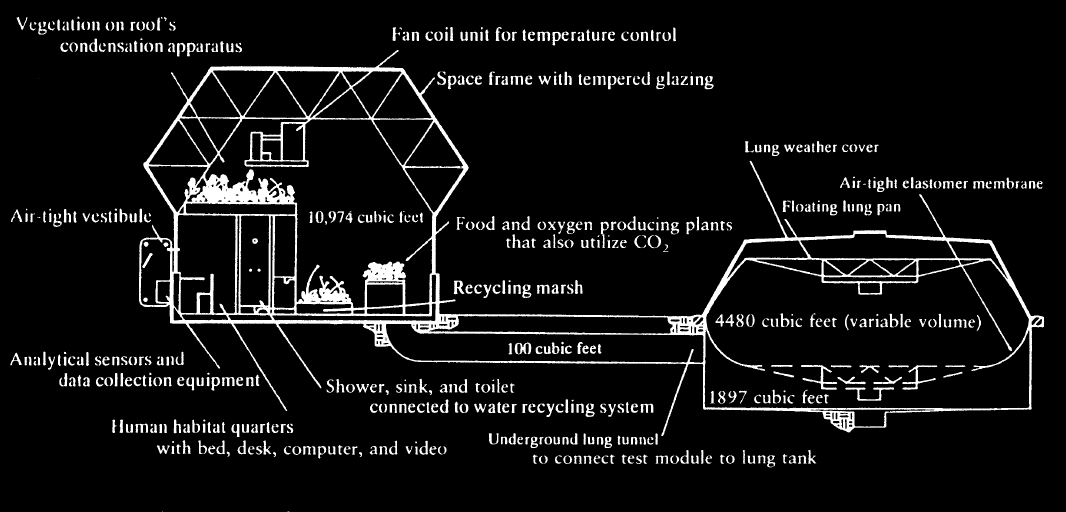
Like its predecessor, SAM² will be a hermetically sealed research station with a healthy internal atmosphere, where temperature, humidity, and carbon dioxide levels are all controlled. All told, SAM² will include the following facilities:
- A greenhouse built from the iconic Biosphere 2 Test Module
- A bermed 8’ x 8’ x 40’ crew quarters and massive 1/2 acre Mars yard
- A fully functional, bi-directional airlock
- ECLSS support for the crew of 4
- Pressure suits for entry, exit, and real EVAs, run at 1.0 psi over ambient
- Simulated regolith (crushed basalt) grow beds and hydroponics
- Support for biology, ecology, robotics, human factors, and more …
- Support for dozens of simultaneous experiments
- Full interior climate control
- Delayed WiFi data delivery, remote monitoring, and control
- On-site accommodations for support crew and equipped mission control center
- Access to adjacent biology lab to stabilize samples and conduct basic analysis
It will also have an ideally-situated next to the ½ acre “Mars Yard,” which will be used to conduct pressure suit and EVA tests, as well as tool and rover evaluations. As with other analogs (like those mentioned above), crews will propose research projects to be carried out during the experiment. These will include studies in the fields of biology, plant physiology, soil ecology, regolith chemistry, and food cultivation, personal psychology, tool use, and habitation studies.
Due to their importance for future missions, research into artificial intelligence and machine learning, robotics, haptics, and other advanced technologies will also be carried out. Once accepted, teams of four will be able to live within SAM² while the additional crew can stay on the B2 campus. SAM² staff will be on hand to install and configure remotely-operated experiments and provide continuous remote monitoring, data collection, and transmission.
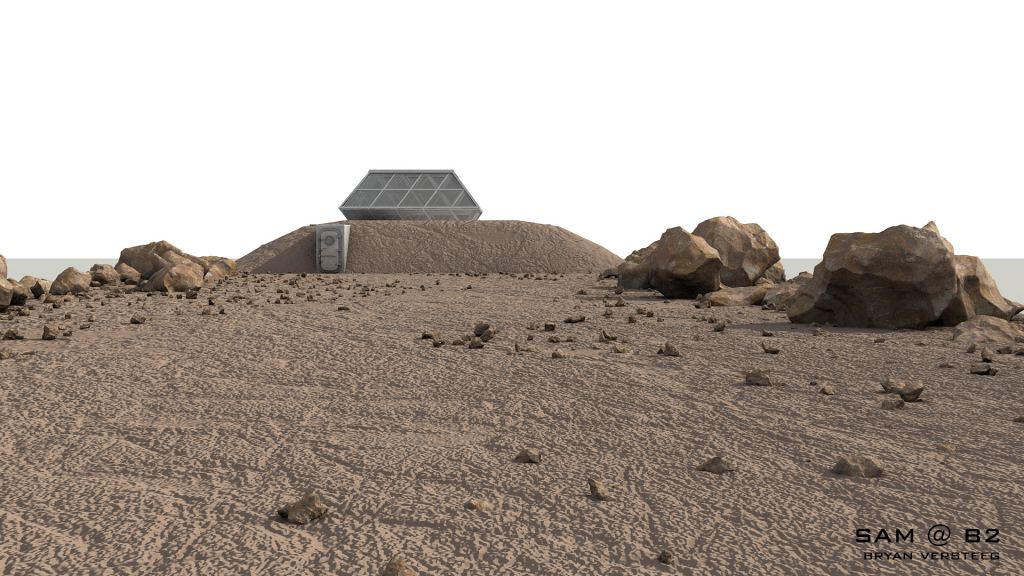
In all of these respects, the SAM² project will take what started with B2 and go further so that we may learn all we can about humans living in closed-loop systems beyond Earth. This is especially crucial considering that, as a species, we find ourselves in a period of renewed space exploration. As Staats explained, there is no better place to do this than on the historic B2 grounds:
“SAM2 is incredibly fortunate to be built around the historic Test Module where the first experiments were conducted at Biosphere 2 in sealed, human-in-the-loop bioregeneration of air, water, and food. There is no better place, no better heritage to carry forward as continuing research in this field of study. We have at our disposal staff members who have worked at Biosphere 2 for thirty years, their understanding of the inner workings of complex infrastructure imperative to our success.
“Furthermore, we will gain from the rich heritage of science conducted at the Biosphere 2 since its transition into an open research center (meaning no longer sealed), the largest of its kind in the world. When we move to install sensors, monitors, and instruments, we will have gained from what worked and what could have been improved in the original Biosphere 2 experiment, and then benefit from the twenty years of science conducted there since.
“Finally, we have in our working group the support of Jane Poynter and Taber MacCallum, two of the original Biospherians. Taber and William Dempster were the original designers of the Test Module around which we are building SAM.”
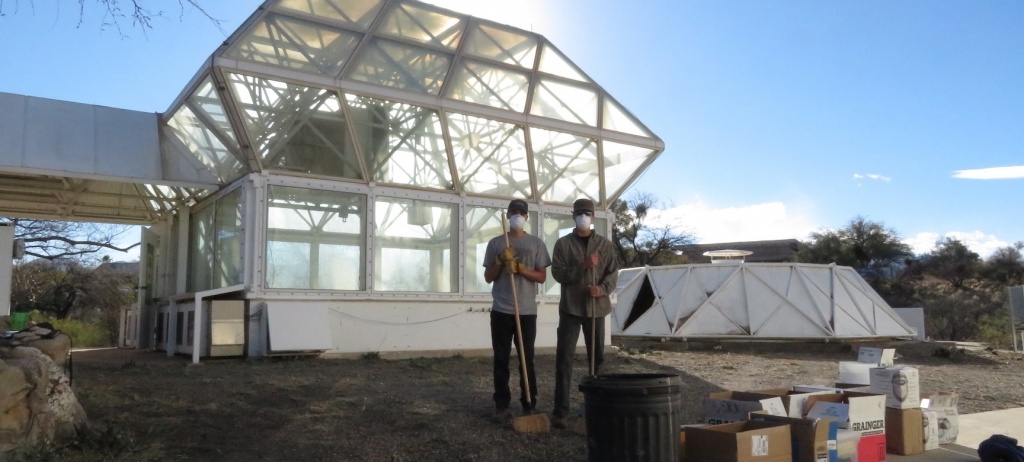
Unlike MDRS, Hi-SEAS, Concordia, and other remote analog environments, SAM² will be accessible to the public and scientific community. For starters, the experiment will be in direct view of all the people visiting Biosphere 2 (at the discretion of the visiting team, of course), and visitors will be able to observe the research and experiments that are being conducted via mixed digital media.
Where applicable, they will also get the chance to interact with the support crew and visiting scientists. This will provide an unparalleled opportunity for science outreach and education in the STEMs, not to mention lucrative opportunities for citizen scientists and researchers. As indicated on their website, the goals of the SAM² are fivefold:
- Transition from physicochemical (mechanical) to bioregenerative (plant-based) environmental control and life support systems (ECLSS).
- Transformation of simulated regolith (crushed basalt) to fertile soil.
- Use of pressurized suits for all EVA activities, including tool use, construction and repair, data collection, and communication.
- Study the evolution of the microbial community of a transitional, hermetically sealed space occupied by both humans and plants.
- Development of computer models that accurately describe a functional, sustainable, long-duration hybrid ECLSS.
SAM² was designed in concert with senior staff at B2 (such as Deputy Director John Adams), plant experts from the University of Arizona’s Controlled Environment Agriculture Center (CEAC), the Paragon Space Development Corporation (SCD), and NASA.
Simulating Life on Mars
Once complete, SAM² will be the most high-fidelity Mars analog and research center in the world, enabling scientists to study the transition from first crew arrival with mechanical life support to multi-year bioregeneration. The data accumulated from the SAM² experiment will be a critical part of the larger research effort to create sustainable living solutions for the Moon and/or Mars.
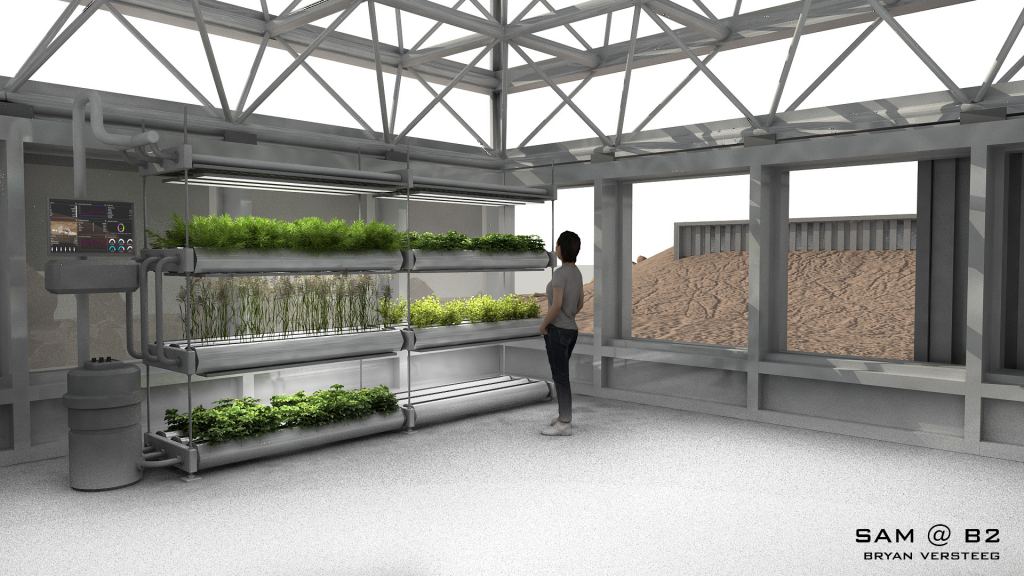
At the same time, said Adams, the lessons learned will have applications here at home, where sustainability is being sought to address the problems of climate change:
“Like Biosphere 2, the test module will provide great insight into the fundamental processes that tie Earth Systems together. The science program associated with this facility is transformational. We will tackle the problem of climate change while focusing on three grand challenges in science: integrating multiple disciplines (e.g., hydrology, ecology, geology, chemistry, atmospheric sciences), applying instrumental calibration to large-scale and adaptable biological systems, and developing an understanding of how earth system processes scale in time and space (e.g., from cells to organisms, communities, landscapes, and the globe).”
“As with all analogs, even those conducted by NASA in the 1960s, we are practicing techniques, testing procedures, and conducting experiments to further inform known gaps in the taxonomy of human space travel,” added Staats. “NASA summarizes this process in their Human Research Program (HRP) architecture with a Risk analysis, Gaps determination, and Evidence-based assessment of how to reduce the risks and close the gaps. We are working to do just that, to help bring our species closer to the reality of long-duration habitation of another planetary body in our solar system.”
Staats and his colleagues have also developed a software tool known as SIMOC, which stands for Scalable, Interactive Model of an Off-world Community. This hi-fidelity computer simulation was launched with Nat Geo in June of 2020 with the long-term goal of tying into the SAM² experiment for real-time data capture. Eventually, it is hoped that SIMOC will lead to AI-driven system management of SAM².
Basically, SIMOC allows users to create their own virtual habitat on Mars and teaches how success in a closed-system is all about understanding the careful balance of living and non-living systems. As Staats explained it:
“SIMOC is a research-grade model with an educational web interface. It is well received for its authentic science core and expert interface for citizen scientists–design a habitat and set it in motion to learn which combinations of crew quarters, ECLSS, greenhouse and plants, solar PV and batteries work, and which fail.
“The model is founded on published data derived from life support and closed ecosystem research at NASA and universities world-wide. The users are invited to design a habitat that sustains human life through a combination of physicochemical (mechanical) and bioregenerative (living plant) systems, selecting various combinations of crew quarters, greenhouse, food and plants, energy generation and storage, and mission duration.”
Bold Steps Being Taken
Over forty years of NASA data went into the creation of SIMOC, as well as the guidance and input provided by the Paragon Space Development Corp, the University of Arizona, and Arizona State University. Staats and his colleagues also had the honor of seeing SIMOC incorporated into the Mars City Design 2020 Competition.
Every year since it was created in 2016, Mars City Design founder Vera Mulyania and her colleagues have hosted an annual “Marschitecture” event. These competitions are dedicated to bringing student and professional teams from around the world together with industry experts to come up with innovative solutions for living on Mars.
These solutions are all about leveraging architectural design, advanced technology, in-situ resource utilization (ISRU), ecology, and sustainability to ensure that humans can live and thrive on the Red Planet someday. As Staat related:
“If we are to get to the large-scale dwellings envisioned by Vera and the Mars City Design project, we must first tackle the rudimentary function of atmosphere, water, and waste recycling; and learn how to balance mechanical and bioregenerative life support for long-duration missions.”
On Dec 11th, Staats and his colleagues also hosted the second annual SAM2 Symposium. Whereas last year’s Symposium saw about two dozen participants attend at the University of Arizona (or online) to discuss the SAM2 concept, this year’s Symposium consisted of twelve presenters and over one-hundred people watching the event virtually. In addition to Staats and Adams, those presenting this year included:
- Dr. Joaquin Ruiz, the Executive Director of B2
- Taber MacCallum, one of the original B2 crew and founder of Space Perspective
- Ewan Reid, CEO of Mission Control Space Services
- Trent Tresch and Dr. Cameron Smith of Smith Aerospace Garments
- Ezio Melotti, a Lead Developer for SIMOC
- Anastasiya Stepanova, an engineer at the IBP and SIRIUS
- Dr. Shannon Rupert, Director of the MDRS for the Mars Society
- Bryan Versteeg, renowned conceptual designer for space habitats
Dr. Ruiz highlighted how the lessons of B2 would facilitate the SAM² experiment, paying close attention to how timely such an experiment is right now. As he put it:
“Biosphere 2 started with a dual sort of idea, and one of them was really trying to understand if they could come up with a way of measuring what was a very important theory at the time, which was the Gaia hypothesis. But the second one, of course, was whether the biosphere could create the intellectual properties to go to other planets.
“So after a very complicated life that the biosphere has had… we’re back to one of the original missions of Biosphere 2, and that is how do we actually feed the astronauts if we are really going to go to the Moon for the long term, to Mars for the long term… And it couldn’t be a better time now.
“Everything you read in the newspapers, it really points to a race of various countries to try to put astronauts on the Moon. It’s not quite clear to me that any of them have really thought out – besides the rocketry and safety of the astronauts (to get from their back) – how they are going to live there for a long time.
“So SAM² is clearly a solution, and Kai is a person that I met thanks to the gods of good luck. And since he’s been cranking away with Biosphere 2 and SAM², it’s been a joy to see movement [and] progress not as fast as all of us would like for movement in the right direction… I think you’ll be impressed by how far we’ve moved forward.”
Solving for Space and Earth
As the saying goes, “solving for space solves for Earth.” Nowhere is this relationship more obvious than with Lovelock’s Gaia Hypothesis or the ecological, climatological, and biological research that went into the creation of Biosphere 2. These experiments were made possible thanks to decades of Earth Observation, Earth Science, and the research that allowed NASA to put footprints and flags on the Moon.

In short, going to space has taught us just about everything we know about planetary systems – particularly our own. The same is true of SAM², an experiment that’s taking place during an era of renewed space exploration. But unlike the Space Race, the missions headed to the Moon in this decade (and to Mars in the 2030s) include the creation of permanent infrastructure.
For human beings to live and work on the Moon, in orbit, and on Mars, they will need to be as self-sufficient as possible. This means leveraging local resources, growing food, and creating closed-loop environments that will endlessly recycle its water and air and be sustainable over the long haul. In other words, they will need environments that are as close to Earth and natural systems as humanly possible.
The innovations that this research inspires will also have endless applications here at home. In the coming decades, the global population is expected to swell to just shy of 10 billion people, and at a time when climate change is disrupting the very systems that we depend upon for our livelihood and survival. The only way we are going to live long enough to embrace the dream of “going interplanetary” (and all the benefits that this will entail) is to think in terms of sustainability and renewable resources.
There are some who would say, “let’s fix Earth before we go to the Moon, Mars, and beyond.” Others insist that the two are not mutually exclusive. But the reality is that the two are inextricably intertwined. It also wouldn’t be an exaggeration to say that we won’t be able to do the one without the other. So if we hope to do either, we need to make sure that we accumulate all the data we could possibly need.

With all of the solutions that these will lead to, human beings may finally achieve the dream of becoming an interplanetary species while also ensuring our survival here at home.
In addition to senior staff at B2, experts from the University of Arizona’s Controlled Environment Agriculture Center (CEAC), Nat Geo, and NASA, additional support for the SAM² experiment was provided by the Paragon Space Development Corporation (SCD), Smith Aerospace Garments, LLC, and the Arizona Science Center.
For more information and updates on the progress of SAM2 at B2, check out their website!
Sources:
- SAM2 at B2
- NASA – About Analog Missions
- University of Arizona – Biosphere 2
- University of Arizona – Fast Facts/Biosphere 2
- Marino, B.D.V. (et al.) “The agricultural biome of Biosphere 2: Structure, composition, and function.” Ecological Engineering, Vo. 13, No. 1–4 (1999)
- MacCallum, T. (et al.) “Lessons Learned from Biosphere 2: When Viewed as a Ground Simulation/Analogue for Long Duration Human Space Exploration and Settlement.” 35th COSPAR Scientific Assembly (2002)
- Nelson, M., Hawes, P., Augustine, M. “Life Systems for a Lunar Base.” NASA Conference Publications (1992)
- Nelson, M. (et al.) “Closed Ecological Systems, Space Life Support, and Biospherics.“ Advances in Space Research, Vol. 31, No. 7 (2003)
- Rand, L. R. “Colonizing Mars: Practicing Other Worlds on Earth.” Origins (OSU), Vol. 11, No. 2 (2017)
- Staats, K. & Adams, J. “SAM@B2 – a Study of Analog Missions for the Moon and Mars, at Biosphere 2.” (2020)

